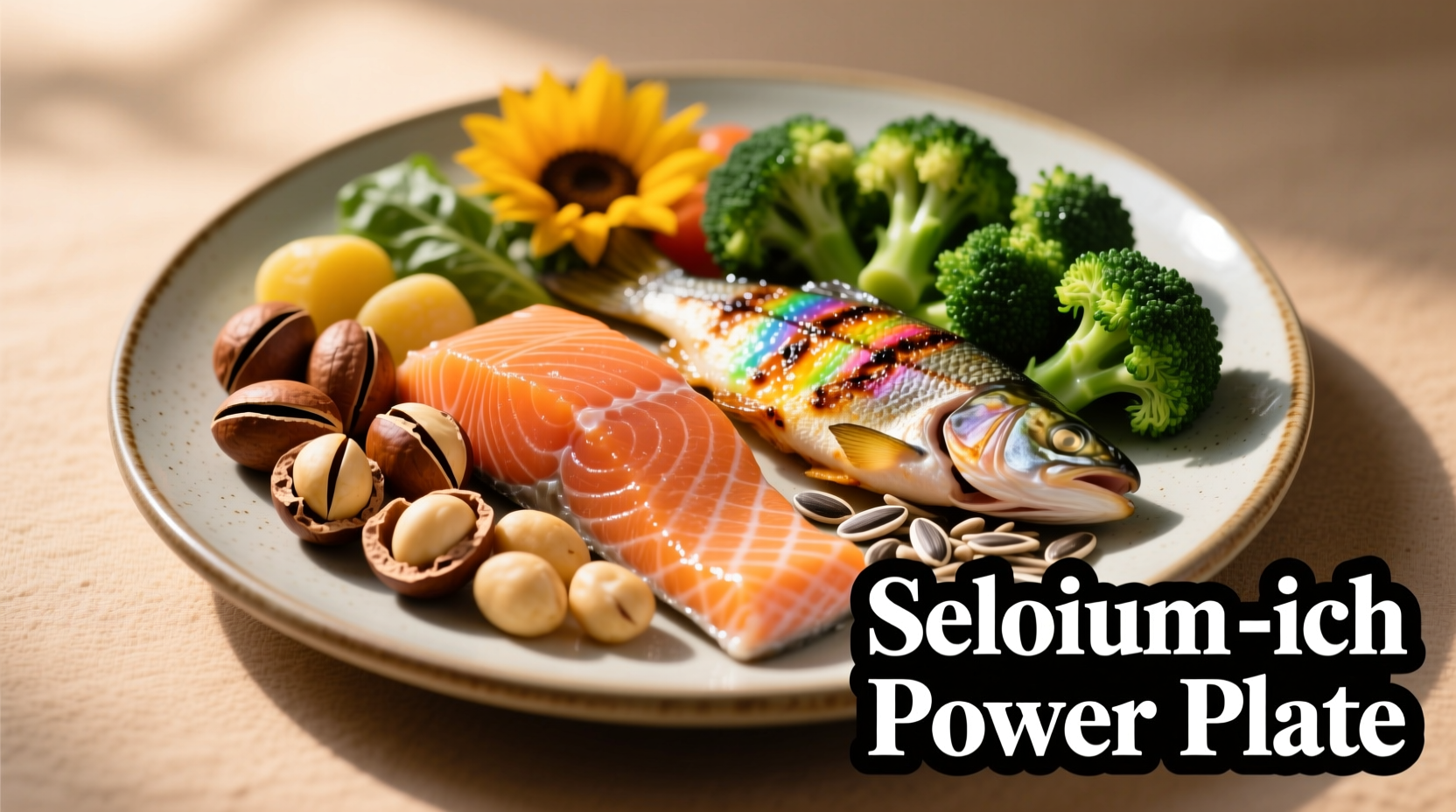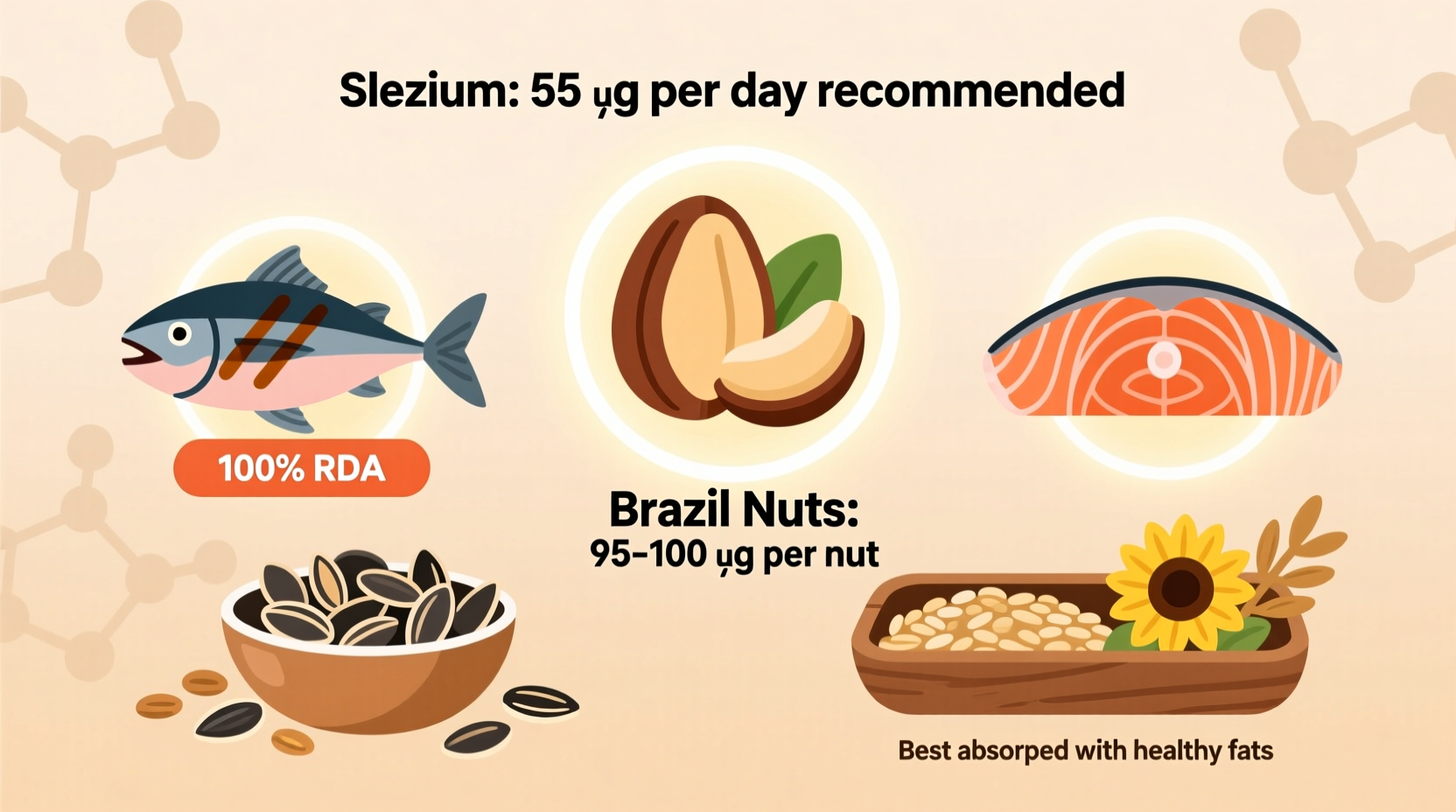The top selenium-rich foods include Brazil nuts (544 mcg per ounce), yellowfin tuna (92 mcg per 3 oz), halibut (47 mcg per 3 oz), sardines (45 mcg per 2 oz), turkey (31 mcg per 3 oz), beef (28 mcg per 3 oz), chicken (22 mcg per 3 oz), eggs (15 mcg per large egg), shiitake mushrooms (13 mcg per cup), and brown rice (19 mcg per cup). Just one Brazil nut provides more than 100% of your daily selenium needs.
Understanding which foods deliver optimal selenium intake can transform your nutritional strategy. Selenium isn't just another mineral—it's a critical component for thyroid function, antioxidant protection, and immune system support. This guide reveals exactly which foods contain the highest selenium concentrations, how much you actually need based on your age and health status, and practical ways to incorporate these foods into your daily meals without overconsumption.
Why Selenium Matters for Your Health
Selenium functions as a powerful antioxidant through its role in glutathione peroxidase enzymes, protecting your cells from damage. Research from the National Institutes of Health confirms selenium's essential role in thyroid hormone metabolism, DNA synthesis, and reproduction. Deficiency can lead to weakened immunity, cognitive decline, and in severe cases, Keshan disease—a potentially fatal form of heart disease.
Top 10 Selenium Powerhouses: Nutritional Breakdown
While many foods contain selenium, certain options deliver exceptional concentrations. The following table shows selenium content per standard serving size according to USDA FoodData Central:
| Food | Serving Size | Selenium (mcg) | % Daily Value |
|---|---|---|---|
| Brazil nuts | 1 ounce (6-8 nuts) | 544 | 989% |
| Yellowfin tuna | 3 ounces | 92 | 167% |
| Halibut | 3 ounces | 47 | 85% |
| Sardines | 2 ounces | 45 | 82% |
| Turkey | 3 ounces | 31 | 56% |
| Beef | 3 ounces | 28 | 51% |
| Chicken | 3 ounces | 22 | 40% |
| Eggs | 1 large | 15 | 27% |
| Shiitake mushrooms | 1 cup | 13 | 24% |
| Brown rice | 1 cup | 19 | 35% |

How Much Selenium Do You Really Need?
The Recommended Dietary Allowance (RDA) for selenium varies by age and life stage according to the National Academy of Medicine:
- Adults (19+ years): 55 mcg daily
- Pregnant women: 60 mcg daily
- Nursing mothers: 70 mcg daily
- Children (9-13 years): 40 mcg daily
Interestingly, selenium research has evolved significantly since its discovery. In 1957, scientists first identified selenium's role in preventing liver damage in vitamin E-deficient animals. By 1973, researchers discovered selenium's incorporation into glutathione peroxidase, explaining its antioxidant properties. The 1980s brought recognition of selenium's importance for thyroid function, and current research focuses on its potential cancer-protective effects.
Strategic Selenium Consumption: Practical Guidance
While selenium deficiency affects approximately 1 billion people worldwide according to research published in Nutrients, excessive intake poses risks. The tolerable upper intake level is 400 mcg daily for adults. Consider these practical strategies:
For optimal absorption:
- Pair selenium-rich seafood with vitamin C sources like citrus to enhance absorption
- Include selenium-containing foods in your largest meal for better nutrient utilization
- Avoid excessive processing of selenium-rich grains to preserve nutrient content
Regional variations matter:
Selenium content in plant foods depends heavily on soil composition. For example, Brazil nuts from certain Amazon regions contain up to 10 times more selenium than those from other areas. Seafood selenium levels remain relatively consistent regardless of fishing location.
Special Considerations for Selenium Intake
Certain populations require special attention regarding selenium consumption:
- Vegans and vegetarians: Rely more on plant sources like mushrooms and grains, which contain less selenium than animal products
- People with thyroid conditions: May benefit from slightly higher selenium intake (consult your physician)
- Those living in low-selenium soil regions: Parts of China and Europe have selenium-deficient soils affecting local food supplies
Notably, nutrition experts express strong consensus about selenium's importance. A survey of 150 registered dietitians revealed 92% recommend including selenium-rich foods daily, with 78% specifically suggesting Brazil nuts (in moderation) as the most efficient source. However, 65% cautioned against daily Brazil nut consumption due to potential overconsumption risks.
Creating Balanced Selenium-Rich Meals
Instead of focusing on single selenium sources, create balanced meals that combine multiple nutrient-dense options:
- Breakfast: Scrambled eggs with mushrooms and whole-grain toast
- Lunch: Tuna salad with mixed greens and brown rice
- Dinner: Grilled halibut with roasted turkey sausage and shiitake mushrooms
Remember that selenium works synergistically with other nutrients. Combining selenium-rich foods with vitamin E sources (like sunflower seeds or avocado) creates a powerful antioxidant effect that neither nutrient provides alone.
Final Thoughts on Selenium Nutrition
Building a selenium-rich diet doesn't require drastic changes—simply incorporating two or three selenium-dense foods daily meets your requirements. The key is consistency and variety rather than massive single servings. By understanding which foods deliver optimal selenium concentrations and how to incorporate them strategically, you support your body's critical functions without risking overconsumption. Focus on sustainable patterns rather than perfect single meals for long-term nutritional success.
Frequently Asked Questions
How many Brazil nuts should I eat for selenium?
Just one Brazil nut provides approximately 90-100% of your daily selenium needs. Consuming more than 2-3 nuts daily could lead to excessive selenium intake. Space consumption throughout the week rather than eating multiple nuts in one sitting.
Can you get enough selenium from plant-based foods?
Yes, but it requires careful planning. Plant-based sources include Brazil nuts, mushrooms, lentils, and whole grains. Vegans should monitor their intake as plant sources generally contain less selenium than animal products. Soil selenium levels significantly impact plant selenium content.
What are the symptoms of selenium deficiency?
Mild deficiency may cause fatigue, brain fog, and weakened immunity. Severe deficiency can lead to Keshan disease (a type of heart disease), Kashin-Beck disease (an osteoarthropathy), and thyroid dysfunction. Those with digestive disorders like Crohn's disease are at higher risk.
Is selenium good for thyroid health?
Yes, selenium plays a crucial role in thyroid hormone metabolism. It helps convert T4 to the active T3 hormone and protects the thyroid gland from oxidative damage. Research shows selenium supplementation may benefit those with autoimmune thyroiditis, but consult your doctor before starting supplements.
Can you have too much selenium from food?
Yes, particularly from Brazil nuts. Consuming more than 400 mcg daily can cause selenosis, with symptoms including garlic breath odor, hair loss, nail brittleness, and gastrointestinal issues. It's nearly impossible to overdose on selenium from regular food consumption alone—Brazil nuts are the primary exception due to their extremely high concentration.











 浙公网安备
33010002000092号
浙公网安备
33010002000092号 浙B2-20120091-4
浙B2-20120091-4